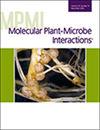求助PDF
{"title":"互交霉Mip1/RAPTOR通过调节毒素产生和自噬介导毒力。","authors":"Yu-Ling Huang, Kuang-Ren Chung, Pei-Ching Wu","doi":"10.1094/MPMI-12-24-0161-R","DOIUrl":null,"url":null,"abstract":"<p><p>The necrotrophic pathogen <i>Alternaria alternata</i> produces a host-selective toxin to attack its host plants. This study characterized the crucial function of the Mip1/RAPTOR ortholog (AaMip1) in toxin production and autophagy formation. AaMip1 physically interacts with the Target of Rapamycin (Tor) protein. In response to nitrogen starvation and hydrogen peroxide (H<sub>2</sub>O<sub>2</sub>), AaMip1 binds to Tor and triggers autophagy and oxidative stress detoxification. Deleting the <i>AaMip1</i> gene resulted in a Δ<i>AaMip1</i> strain that increased sensitivity to various oxidants; decreased the expression of two oxidative-stress-response genes, <i>AaYap1</i> and <i>AaNoxA</i>; and had lower catalase activity than the wild type. Δ<i>AaMip1</i> produced lower levels of ACT toxin than the wild type after a 7-day incubation; however, Δ<i>AaMip1</i> produced tricycloalternarene mycotoxins but not ACT after 21 days. The reduction of Δ<i>AaMip1</i> virulence in the host plant is due to low ACT production, defective H<sub>2</sub>O<sub>2</sub> detoxification, impaired autophagy, and slow growth during invasion. However, AaMip1 plays a negative role in maintaining cell wall integrity and lipid body accumulation. Δ<i>AaMip1</i> had thicker cell walls and emitted brighter red fluorescence after staining with the cell-wall-disrupting agents Congo red and calcofluor white. Δ<i>AaMip1</i> was more resistant to these compounds than the wild type under nutrient-rich conditions. The observed defects in the Δ<i>AaMip1</i> were restored in the complementation strain after re-expressing a functional copy of <i>AaMip1</i>. This study increases our understanding of how <i>A. alternata</i> deals with toxic reactive oxygen species, triggers autophagy formation, maintains normal cell wall integrity, and regulates toxin metabolism via the AaMip1-mediated signaling pathways. [Formula: see text] Copyright © 2025 The Author(s). This is an open access article distributed under the CC BY-NC-ND 4.0 International license.</p>","PeriodicalId":19009,"journal":{"name":"Molecular Plant-microbe Interactions","volume":" ","pages":"610-622"},"PeriodicalIF":3.4000,"publicationDate":"2025-07-01","publicationTypes":"Journal Article","fieldsOfStudy":null,"isOpenAccess":false,"openAccessPdf":"","citationCount":"0","resultStr":"{\"title\":\"The <i>Alternaria alternata</i> Mip1/RAPTOR Mediates Virulence by Regulating Toxin Production and Autophagy.\",\"authors\":\"Yu-Ling Huang, Kuang-Ren Chung, Pei-Ching Wu\",\"doi\":\"10.1094/MPMI-12-24-0161-R\",\"DOIUrl\":null,\"url\":null,\"abstract\":\"<p><p>The necrotrophic pathogen <i>Alternaria alternata</i> produces a host-selective toxin to attack its host plants. This study characterized the crucial function of the Mip1/RAPTOR ortholog (AaMip1) in toxin production and autophagy formation. AaMip1 physically interacts with the Target of Rapamycin (Tor) protein. In response to nitrogen starvation and hydrogen peroxide (H<sub>2</sub>O<sub>2</sub>), AaMip1 binds to Tor and triggers autophagy and oxidative stress detoxification. Deleting the <i>AaMip1</i> gene resulted in a Δ<i>AaMip1</i> strain that increased sensitivity to various oxidants; decreased the expression of two oxidative-stress-response genes, <i>AaYap1</i> and <i>AaNoxA</i>; and had lower catalase activity than the wild type. Δ<i>AaMip1</i> produced lower levels of ACT toxin than the wild type after a 7-day incubation; however, Δ<i>AaMip1</i> produced tricycloalternarene mycotoxins but not ACT after 21 days. The reduction of Δ<i>AaMip1</i> virulence in the host plant is due to low ACT production, defective H<sub>2</sub>O<sub>2</sub> detoxification, impaired autophagy, and slow growth during invasion. However, AaMip1 plays a negative role in maintaining cell wall integrity and lipid body accumulation. Δ<i>AaMip1</i> had thicker cell walls and emitted brighter red fluorescence after staining with the cell-wall-disrupting agents Congo red and calcofluor white. Δ<i>AaMip1</i> was more resistant to these compounds than the wild type under nutrient-rich conditions. The observed defects in the Δ<i>AaMip1</i> were restored in the complementation strain after re-expressing a functional copy of <i>AaMip1</i>. This study increases our understanding of how <i>A. alternata</i> deals with toxic reactive oxygen species, triggers autophagy formation, maintains normal cell wall integrity, and regulates toxin metabolism via the AaMip1-mediated signaling pathways. [Formula: see text] Copyright © 2025 The Author(s). This is an open access article distributed under the CC BY-NC-ND 4.0 International license.</p>\",\"PeriodicalId\":19009,\"journal\":{\"name\":\"Molecular Plant-microbe Interactions\",\"volume\":\" \",\"pages\":\"610-622\"},\"PeriodicalIF\":3.4000,\"publicationDate\":\"2025-07-01\",\"publicationTypes\":\"Journal Article\",\"fieldsOfStudy\":null,\"isOpenAccess\":false,\"openAccessPdf\":\"\",\"citationCount\":\"0\",\"resultStr\":null,\"platform\":\"Semanticscholar\",\"paperid\":null,\"PeriodicalName\":\"Molecular Plant-microbe Interactions\",\"FirstCategoryId\":\"99\",\"ListUrlMain\":\"https://doi.org/10.1094/MPMI-12-24-0161-R\",\"RegionNum\":3,\"RegionCategory\":\"生物学\",\"ArticlePicture\":[],\"TitleCN\":null,\"AbstractTextCN\":null,\"PMCID\":null,\"EPubDate\":\"2025/7/9 0:00:00\",\"PubModel\":\"Epub\",\"JCR\":\"Q2\",\"JCRName\":\"BIOCHEMISTRY & MOLECULAR BIOLOGY\",\"Score\":null,\"Total\":0}","platform":"Semanticscholar","paperid":null,"PeriodicalName":"Molecular Plant-microbe Interactions","FirstCategoryId":"99","ListUrlMain":"https://doi.org/10.1094/MPMI-12-24-0161-R","RegionNum":3,"RegionCategory":"生物学","ArticlePicture":[],"TitleCN":null,"AbstractTextCN":null,"PMCID":null,"EPubDate":"2025/7/9 0:00:00","PubModel":"Epub","JCR":"Q2","JCRName":"BIOCHEMISTRY & MOLECULAR BIOLOGY","Score":null,"Total":0}
引用次数: 0
引用
批量引用

 求助内容:
求助内容: 应助结果提醒方式:
应助结果提醒方式:


